Best Acoustic Electric Guitar | 6 Best Under $1,000
If you’re looking for an acoustic-electric guitar for gigging, the sub $1000 offers a lot of great options. Featured here are the best acoustic electric guitar under $1000, divided into sub $500, and $500 to $1000 price ranges.
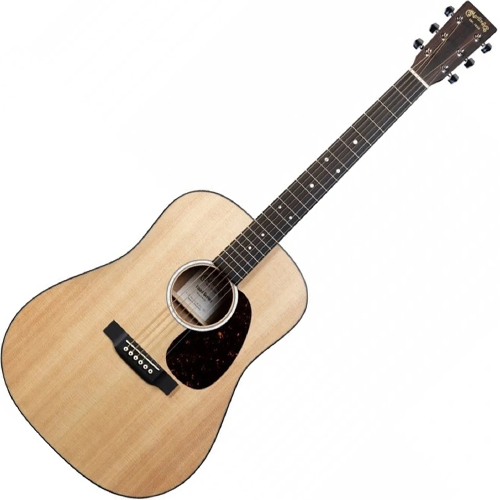
Martin D-10e Road Series
The Martin D-10E Road Series Dreadnought blends quality materials and convenient features. It is backed by a manufacturer synonymous with great acoustic guitars.
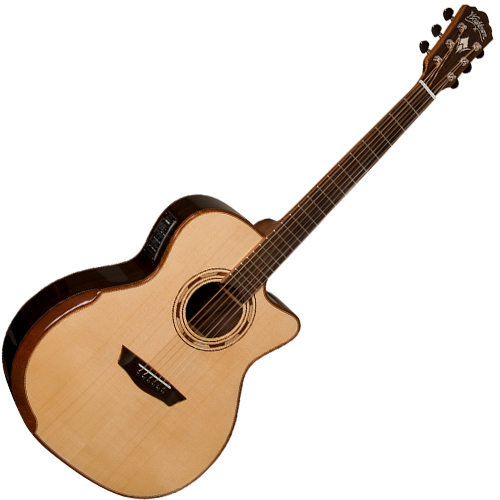
Washburn Comfort G25SCE
The Takamine GJ72CE is a guitar with a unique body design for powerful projection. It also has a versatile preamp system that caters to your tone-shaping needs.
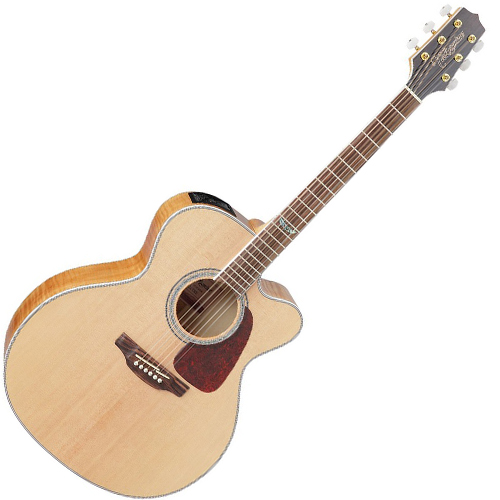
Takamine GJ72CE
The Takamine GJ72CE is a guitar with a unique body design for powerful projection. It also has a versatile preamp system that caters to your tone-shaping needs.
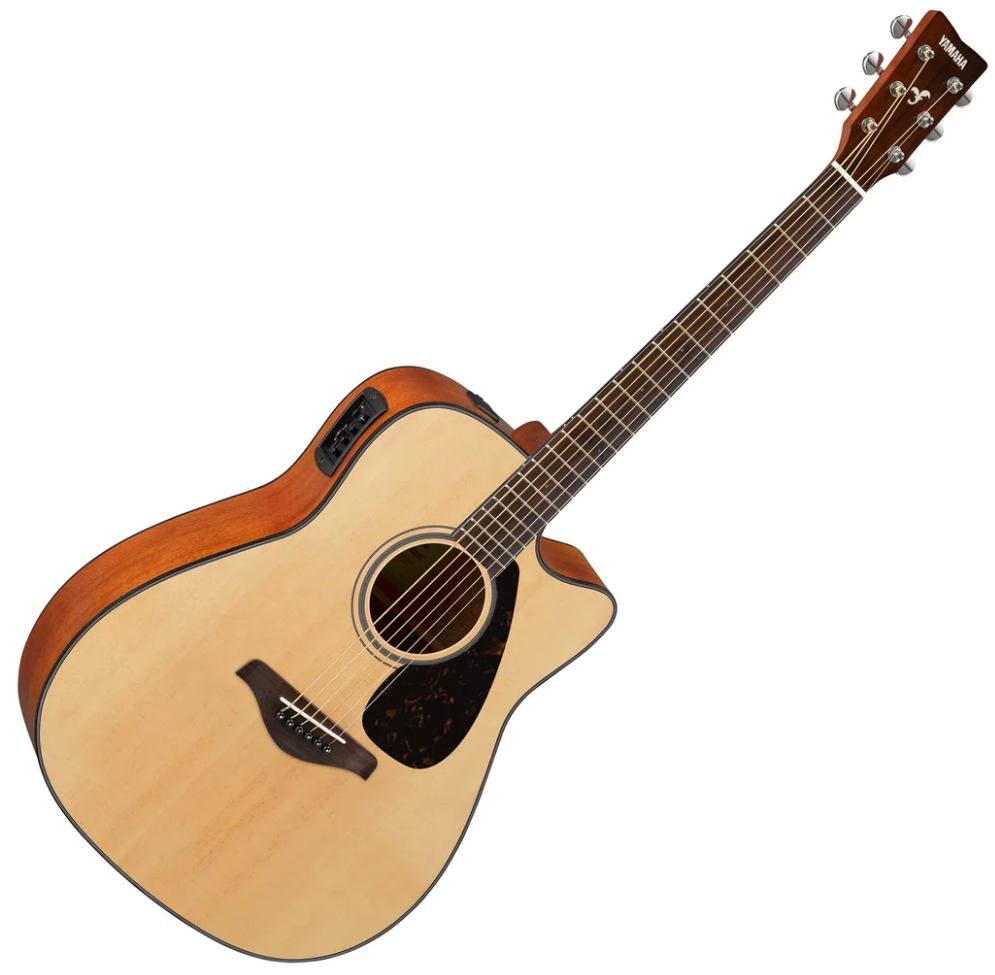
Yamaha FGX800C
The Yamaha FGX800C guitar is from Yamaha's FG Folk Guitar line and is the cheapest in the guide. It has a nice balance of playability, sound quality, and affordability.
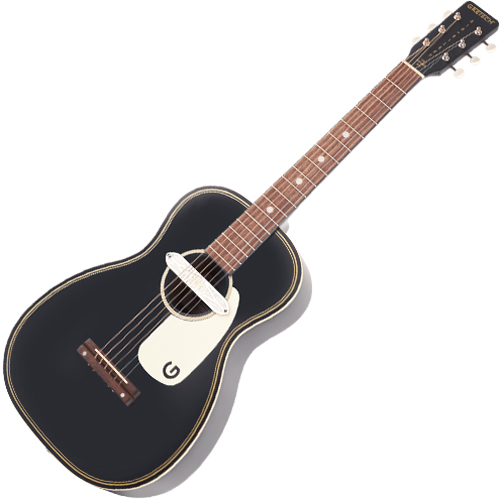
Gretsch G9520E
The Gretsch G9520E stands out in this guide for its distinctive pickup system. This acoustic-electric guitar has a comfortable parlor-shaped body style that adds a distinct texture to its sound.
We’re reader-supported. When you click product links on our site, we may earn an affiliate commission at no extra cost to you.
Have you noticed that guitar stores offer more pickup-equipped acoustic guitars than their regular counterparts?
The reason is simple: you get more mileage from an acoustic-electric guitar.
The built-in pickup system allows acoustic guitars to be used on stage conveniently without the need for complex mic setups.
This added functionality means more value, making acoustic-electric guitars more appealing, especially for the gigging singer songwriter.
This is particularly true in the sub $1000, which is the price point that most active musicians are willing to invest. Based on value alone, pickup equipped versions are the best acoustic guitars.
Featured here are the best acoustic-electric guitars under $1000, offering stage-ready tone, playability, and reliability for the active guitar player.
We’ve divided the guide into 2 price ranges, sub $500, and sub $1000 ($500 to $1000).
If your budget is limited, look at our Cheap Acoustic Electric Guitars Under $200 guide.
- Table of Contents
Best Acoustic-Electric Guitar under $1000
Martin D-10e Road Series
Best Acoustic-Electric Guitar (Overall)

Martin D-10e Road Series Acoustic-Electric Gutiar
Guitarsite Expert Opinion
The Martin D-10E Road Series Dreadnought blends quality materials and convenient features. It is backed by a manufacturer that’s synonymous with acoustic guitars.
We’re reader-supported. When you click product links on our site, we may earn an affiliate commission at no extra cost to you.
Finding Martin Guitars in this price range is quite special. And as expected, the Martin D-10E Road Series Dreadnought is a solid option if you’re looking for a high-quality acoustic guitar.
It’s constructed with solid wood that delivers a great sound. They’ve added details such as the mother-of-pearl pattern fingerboard and rosette inlays. Pair that with a multi-stripe rosette border, and you get a guitar with a classy look,
Its build features a durable and stable FSC®-certified Richlite® fingerboard and bridge. The satin-finished body and hand-rubbed neck finish add to its comfort and playability.
Plus, they’ve included Martin E-1 electronics with a built-in soundhole tuner. This feature is handy for tuning up on the fly without needing a pedal; however, placing it inside the soundhole is unorthodox.
It also comes with a premium soft shell case. So it’s ready to hit the road with you.
Overall, the Martin D-10E offers good sound quality and convenience, all at a reasonable price (for a Martin). It’s an acoustic-electric that’s road-ready, sounds great, and is made by a trusted, iconic manufacturer.
Pros:
- Classic Martin dreadnaught sound
- Solid top construction
- Great fit and finish
- Great sounding pickup
Cons:
- Soundhole mounted controls can be awkward at first
Specifications: | |
|---|---|
Body Shape: Dreadnought | Electronics: Martin E-1 |
Top: Spruce | Body: Sapele |
Neck: Select Hardwood | Fretboard: FSC Certified Richlite |
Frets: 20 | Saddle Radius: 16″ |
Scale Length: 25.4″ | Nut Width: 1.75″ |
Washburn Comfort G25SCE
Best Acoustic-Electric Guitar (Design and Comfort)

Washburn Comfort G25SCE Acoustic Electric Guitar
Guitarsite Expert Opinion
Washburn’s Comfort G25SCE is a user-friendly design that emphasizes ease of play. It’s constructed to achieve both style and quality guitar sound.
We’re reader-supported. When you click product links on our site, we may earn an affiliate commission at no extra cost to you.
The Washburn Comfort G25SCE is known for its player-friendly design. This acoustic-electric guitar focuses on comfort and playability.
It has a Venetian cutaway for smooth access to the upper frets. Another is its beveled top at the lower bout, which adds both comfort and unique visual appeal.
In terms of construction, the G25SCE features a solid Sitka spruce top and Pau Ferro back and sides. This offers a balanced guitar tone that is resonant and has good projection. The mahogany/maple-bound body, headstock, Ovangkol fingerboard, and bridge give it an elegant look.
Its electronics include the Fishman Presys+ electronics system, which provides amplified tone-shaping action. It also has tuners with ebonite buttons to ensure you stay in tune.
Overall, the Comfort G25SCE is a nice blend of comfort and tone. With its reliable electronics and construction, it is an instrument that ticks the boxes of style and substance.
Pros:
- Contoured lower bout for comfortable fit
- Crisp and Detailed sound, both plugged in and unplugged.
- Gorgeous wood grain, especially on the back.
- Great value for money
Cons:
- Only has one strap button
Specifications: | |
|---|---|
Body Shape: Grand Auditorium with Cutaway | Electronics: Fishman Presys+ 501T with Tuner |
Top: Solid Sitka Spruce | Body: Pau Ferro |
Neck: Satin Mahogany | Fretboard: Ovangkol |
Frets: 20 | Bridge: Ovangkol |
Scale Length: 25.31″ | Nut Width: 1.75″ |
Takamine GJ72CE
Best Acoustic-Electric Guitar (Tone Shaping)

Takamine GJ72CE Acoustic-Electric Guitar
Guitarsite Expert Opinion
The Takamine GJ72CE is a guitar with a unique jumbo body design for powerful acoustic projection. When plugged in, it sports a versatile preamp system that allows for adaptable tone-shaping.
We’re reader-supported. When you click product links on our site, we may earn an affiliate commission at no extra cost to you.
The Takamine GJ72CE is highly sought after for its huge sound. This electro-acoustic guitar has a jumbo cutaway body, which gives it a loud projection and good bass response.
It boasts a solid spruce top and flame maple back and sides, which enhance the upper frequencies and balance the sound. However, smaller and younger players may find the jumbo body too bulky and uncomfortable.
This guitar has more top-end than most acoustics, which gives it a scooped mid sound combined with the boomy bass. It will appeal to those who prefer crisp and trebly tones but may be too trebly for those who like warm guitar sounds.
Takamine pioneered the built-in pickup and preamp configuration, reflected in their TK-40D preamp. This preamp comes with tone-shaping features, including a 3-band EQ with mid-contour. It also allows you to bypass the EQ if you want to use a pedal or rack-mounted EQ. Other features include a built-in tuner and notch filter.
The body is joined with a slim mahogany neck with a 12″ radius, 25.4″ scale length rosewood fingerboard. The Takamine’s distinct split saddle design produces good intonation and overall sound. Everything about this guitar is well-built, from the wood quality to the fretwork and hardware. Takamine did not compromise aesthetics and put top, back, and fingerboard bindings on this guitar.
If you are looking for a high-quality, reasonably priced jumbo acoustic-electric guitar, then the Takamine GJ72CE is for you.
It is also the most affordable of our best $500–$1000 acoustic-electric guitars, achieving an outstanding balance between quality and affordability.
Pros:
- Full, rich acoustic and plugged-in tones
- Smooth neck and easy finger action.
- Great build quality and finish.
- Good acoustic projection
Cons:
- Bulky body
- Takes a bit of tweaking to get the sound right
Specifications: | |
|---|---|
Body Shape: Jumbo Cutaway | Electronics: Takamine TK-40D |
Top: Solid Spruce | Body: Flame Maple |
Neck: Mahogany | Fretboard: Rosewood |
Frets: 20 | Fingerboard Radius: 12″ |
Scale Length: 25.2″ | Nut Width: 1.6875″ |
Best Acoustic Electric Guitar Under $500
Yamaha FGX800C
Best Acoustic-Electric Guitar (Value for Money)

Yamaha FGX800C Acoustic-Electric Guitar
Guitarsite Expert Opinion
The Yamaha FGX800C is a dreadnought-style guitar with exceptional projection, clarity, and sustain. It is part of Yamaha’s FG Folk Guitar line.
We’re reader-supported. When you click product links on our site, we may earn an affiliate commission at no extra cost to you.
The Yamaha FGX800C is number 1 in our under $500 acoustic electric guitars. A part of Yamaha’s FG Folk Guitar line, the FGX800C, follows the traditional dreadnought-style guitar design.
It has a cutaway, dreadnought body commonly used in electro-acoustic guitars. This body type is famous for its good projection and punch, and the cutaway allows easy access to the upper fret.
The guitar uses solid Sitka spruce for the top, producing good projection, clarity, and sustain. Yamaha’s build quality is impressive, so you can expect the guitar to last a long time and sound better with age as the solid top gets better acclimated.
The FGX800C has more top-end clarity than other similarly priced guitars. However, it does compromise some of the bottom end. Those who are used to boomy-sounding acoustics will notice this subtle difference.
Yamaha’s System 66 electronics equip the guitar for live performances. The built-in 3-band EQ and adjustable middle frequency allow for expanded tone shaping. The transparent-sounding pickup is easy to set up and tweak, and the preamp has a built-in tuner.
Yamaha designed the neck to be easy on the hands, with its thin neck profile, flat 15.75″ radius, and standard 1.675″ nut width. Unfortunately, the saddle and nut are still made from plastic. Therefore, the suggested upgrade for this electro-acoustic guitar is to swap them out for bone or TUSQ to improve note sustain.
The Yamaha FGX800C combines modern playability with a conventional solid-top dreadnought design. It’s also among this list’s two most affordable acoustic electric guitars, making it a budget-friendly yet quality option.
Pros:
- Great guitar sound quality with top-end clarity
- Lightweight and easy to play
- No fret buzz and stays well in tune
- Reasonable price for the quality
Cons:
- Lacks a bit of low-end
- Plastic saddle
Specifications: | |
|---|---|
Body Shape: Dreadnought Cutaway | Electronics: Yamaha System 66 |
Top: Solid Spruce | Body: Nato |
Neck: Nato | Fretboard: Walnut |
Frets: 20 | Fingerboard Radius: 15.75″ |
Scale Length: 25.5″ | Nut Width: 1.675″ |
Gretsch G9520E
Best Compact Acoustic-Electric Gutiar

Gretsch G5920E Acoustic-Electric Guitar
Guitarsite Expert Opinion
The Gretsch G9520E stands out in this guide for its distinctive pickup system. This acoustic-electric guitar diverges from conventional designs and delivers a characteristic amplified tone.
We’re reader-supported. When you click product links on our site, we may earn an affiliate commission at no extra cost to you.
Most electric acoustic guitars have an under-saddle piezo system. The Gretsch G9520E, however, has a magnetic soundhole pickup, which sets it apart from the others.
The Gretsch Deltoluxe magnetic soundhole pickup provides a distinctly gritty and throaty amplified tone. It is an excellent choice for playing folk and blues music and rock and related genres when paired with a guitar amp.
However, it is important to note that the amplified tone may not appeal to those who prefer a transparent acoustic sound. But it can work with other styles, like when doing bluegrass quality licks, gritty blues riffs, big rock chords, and more.
The guitar’s body is based on old parlor guitars. This results in a compact and easy-to-play body that emphasizes midrange frequencies. It’s an ideal choice for folk and blues genres, contrasting the punchy sound of dreadnoughts. However, the smaller body does mean it lacks volume and treble clarity compared to traditional acoustics.
The guitar features a short-scale neck, which results in shorter fret spacing and lower string tension. This makes it easier to play and is ideal for blues styles that require a lot of bending, slide, and vibrato.
Despite its affordable price, Gretsch has mass-produced this electric acoustic guitar without compromising build quality. It has a classic, streamlined “blues box” design that matches its old-school tone.
The Gretsch guitar is excellent for those interested in playing blues, folk, and rock music on a budget. It’s small size also makes it among the most viable travel guitars for singer songwriters. Its unique features make it stand out from other acoustic-electric guitars available on the market.
Pros:
- Compact parlor-style body
- Warm blues box acoustic tone
- Gritty and throaty amplified tone
- Easy to play short-scale neck
Cons:
- Lacks definition and clarity
- Low acoustic projection
Specifications: | |
|---|---|
Body Shape: Gin Rickey Parlor | Electronics: Gretsch Deltoluxe Acoustic Magnetic Soundhole Pickup |
Top: Basswood | Body: Basswood |
Neck: Nato | Fretboard: Walnut |
Frets: 18 | Fingerboard Radius: 12″ |
Scale Length: 24″ | Nut Width: 1.6875″ |
Epiphone Hummingbird Studio
Classic Design
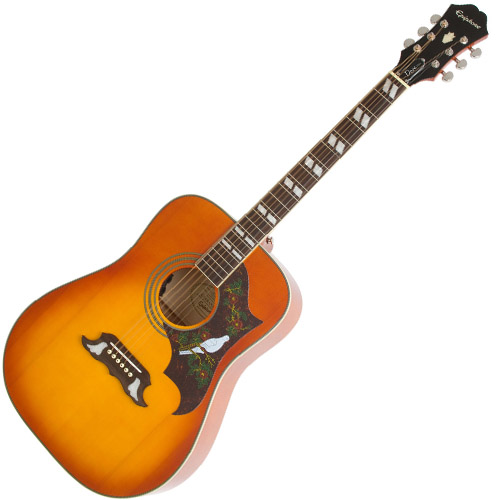
Epiphone Hummingbird Studio Acoustic-Electric Guitar
Guitarsite Expert Opinion
The Epiphone Hummingbird Studio draws inspiration from a beloved 1960s model. It also integrates contemporary enhancements, selected tonewoods, and Epiphone’s reputable service.
We’re reader-supported. When you click product links on our site, we may earn an affiliate commission at no extra cost to you.
This guitar is a nod to the classic 1960s Gibson model but with some modern upgrades. Starting with its Grover Rotomatic tuners, which help keep you in tune.
The Fishman Presys VT electronics system is built-in and offers convenient sound adjustments. And with its soundhole-mounted volume and tone controls, you can easily shape your tone whenever you’re plugged in.
Construction-wise, the solid spruce top and mahogany neck/body combo give it a balanced tone with warmth and good projection. The square shoulder body shape and traditional binding stay true to the original design, and the gloss finish adds a nice touch.
The SlimTaper D-profile mahogany neck and Pau Ferro fingerboard provide a comfortable playing experience. To add some style, it has pearloid twin parallelogram inlays.
Epiphone stands behind the quality of the Hummingbird Studio. It is supported by its Limited Lifetime Warranty and Gibson Brands Customer Service.
It’s an affordable acoustic-electric guitar with modern features and classic appeal.
Pros:
- Classic Gibson Hummingbird Design
- Good value for the price
- Balanced warm tone with good projection
- Stays in tune exceptionally well.
Cons:
- Soundhole Mounted Controls Can be a bit Awkward
Specifications: | |
|---|---|
Body Shape: Square Shoulder Dreadnought | Electronics: Fishman Sonitone / Presys VT |
Top: Solid Spruce | Body: Mahogany |
Neck: Mahogany | Fretboard: Pau Ferro |
Frets: 20 | Fingerboard Radius: 12″ |
Scale Length: 24.724″ | Nut Width: 1.692″ |
Things to Consider in Choosing the Best Acoustic-Electric Guitar
Are Acoustic Electric Guitars Better than Acoustic Guitars with No Built-in Pickup Systems?
Acoustic-electric guitars are similar to traditional acoustic guitars. Their only difference is acoustic electrics’ extra component. So you’re still getting everything you can get from a non-pickup equipped acoustic guitar – the same playability, tone, and looks.
Their main advantage is the convenience of getting amplified without needing external hardware or mics. This ability has changed live performances, making getting good amplified acoustic tones much easier, even in small venues.
Note that recording through mics is still the best choice. However, acoustic electric guitars give us a more convenient option. These advantages are enough reasons for me to consider the electro-acoustic guitar to be the best acoustic guitar for learning.
Types of Acoustic Pickups
None of the different types of pickups are inferior to the others. They have different strengths and weaknesses. They’re also available at various price points and levels of quality, so don’t discount any acoustic guitar pickup out of hand.
There are three main types of acoustic guitar pickups. The first is the piezo pickup, the most common type in production acoustic electrics today. The other two main types are magnetic and transducer. They’re laid out below for ease of reading.
Piezo: This refers to piezoelectric crystals that convert vibrations into an electric current. Piezo pickups are inexpensive to produce and, as such, are the most commonly found pickup in electroacoustics. This is the most common type, seen in popular entry to mid-tier pickups like the ES B from Taylor, Fishman Sonitone, and more. Piezo pickups generally have a bright tone and strong mid-range response. Thankfully, they are bundled with preamps that help make the sound more like an unplugged acoustic guitar. While there’s nothing better than a true mic’ed acoustic tone, the sound quality of piezo preamp systems has steadily improved. This is excellent news both for guitar players and manufacturers.
Magnetic: Contrary to popular belief, magnetic pickups are used on acoustic and electric instruments. These pickups usually sit in the sound hole of a guitar, so they don’t require drilling or permanent modification. They’re also commonly an aftermarket addition, with a few exceptions. These pickups have a more metallic sound than a piezo or a transducer pickup. Although high-end models generally produce a better approximation of an acoustic tone.
Transducer: Transducer pickups are considered the best option if you’re looking for a natural sound/authentic acoustic tone. They have a vibrant and complex tone and retain the general flavor of your guitar’s voice. The only flaw with this pickup type is that it produces more feedback than piezo or magnetic pickups.
Active vs. Passive Pickups
Something to remember when looking for pickups is that you will have to choose between an active or passive pickup system. A passive system transfers the signal from your strings to whatever you use to amplify it. An active pickup, on the other hand, boosts your signal through the use of a battery.
A passive pickup doesn’t produce a very strong signal, which can result in a small amount of volume and an anemic tone. However, the signal can either be boosted at the p.a., your amp, or the most versatile option’ via an acoustic preamp.
Active pickups don’t require any external technology to boost, though they require a battery. This is the most common of the two pickup types, used by the majority of guitar brands, including Ibanez, Washburn, Martin, Taylor Guitars, and more.
Some people still use acoustic preamps for tone shaping and DI benefits. Note that most acoustic electric guitars that are available on the market today come with active preamps.
Tonewoods
Tonewoods are the subject of much debate, so this guide will list the basic qualities of the main ones used by guitars.
Basswood: Although technically a hardwood species, it’s reasonably light and soft. These properties tend to reduce the high-end projection. Gretsch has chosen them for some of their parlor guitars to help emphasize their mid-range.
Spruce: Spruce is the most commonly found top wood on a guitar (the side that faces out while you play). It has a bright tone that suits strumming or fingerpicking, especially when paired with mahogany. The most popular configuration combines a solid spruce top with a mahogany back and sides.
Nato: This is sometimes called “eastern mahogany” due to its similar appearance. Tone-wise, guitarists considers it as a member of the mahogany tone family, with many saying it’s a little brighter. Guitar manufacturers often use it because it is similar to mahogany but cheaper.
Maple: Maple is a tough and dense wood often used on the back and sides, but you will occasionally find it used as a top wood. It has excellent projection but tends to emphasize the mid frequencies too much for many people’s taste as a top wood.
Mahogany: Mahogany emphasizes bass and mid-range frequencies and, as a general rule, has a fairly dark tone. This is often seen on the back and sides, and it is the favorite neck wood for its stability, especially with a truss rod. Koa, another commonly found tonewood, is very similar to mahogany.
Sapele: Sapele is denser than mahogany and produces a slightly brighter sound. Taylor guitars say it adds “top-end shimmer” to the guitars they use it on.
Rosewood: Rosewood is brighter than mahogany, though not as bright as spruce. The resulting tone is bright and focused when paired with spruce, making it well-suited to lead and fingerpicking.
Koa is also known as Hawaiian Koa because it’s a native Hawaiian species. It’s a dense hardwood that emphasizes the mid-to-high overtones, and as it ages, it tends to ‘open up,’ adding warmth to the mid-range. It’s mainly found on high-end guitars due to its high cost.
Laminated vs. Solid Top
The difference between laminate and solid wood is that laminate is several thin sheets of wood glued together. In contrast, solid wood is a single piece of solid wood.
The glue that binds the pieces of laminate together reduces how much your guitar vibrates. This, in turn, lessens your volume and frequency production (tone).
Solid wood resonates more efficiently, making its instruments louder and sound better. And I am definitely a fan of how responsive and lively a solid top acoustic guitar feel. Unfortunately, this acoustic tone isn’t translated well by piezo pickups, which means that it isn’t that much of a big deal when amplified using conventional pickups.
Laminated woods are also more cost-effective, reliable, and resilient to weather changes. Hence they are the practical wood type for a beginner.
Generally, if the specifications don’t say the top wood is solid, it’s laminate.
Conclusion
Acoustic-electric guitars come with built-in pickups and tone-shaping options. This makes them an ideal choice, especially for stage performances.
You get that convenience without compromising playability or tone with the best acoustic electric guitar.
The best acoustic electric guitar under $1000 is one that has the unique set of features and tonal characteristics that fits your playing style. It must suit your taste in sound, playability, and budget constraints.
Alexander Briones
Lead Author
Jerome Arcon
Contributor: Research and Supplemental Writing


4 thoughts on “Best Acoustic Electric Guitar Under $1000”
I have a solid black Dixon electric acoustic guitar with Model DG 5BK
Can you give me some information about what this marking means? Also what year it was made?
Thank you.
Nicely written article and helpful. Thanks for sharing.
or the epi masterbilt
I don’t understand how you cannot include the PRS SE Angelus in this. I have a Taylor Dreadnought and the PRS usually gets pulled out first.